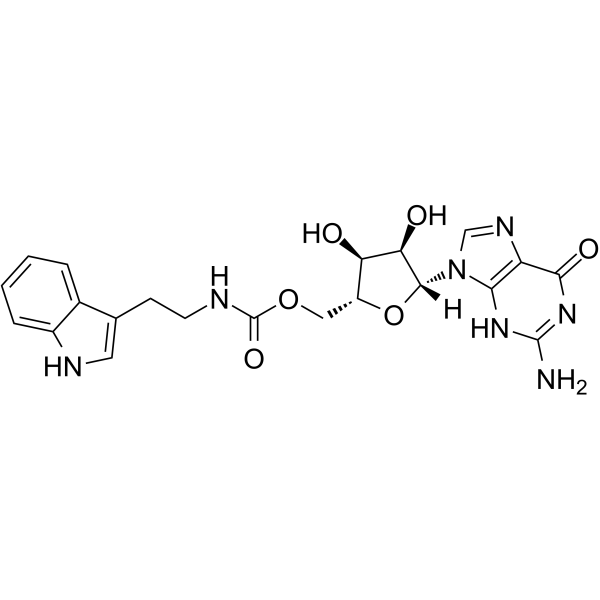Tryptamine guanosine carbamate
Modify Date: 2025-08-26 20:38:47

Tryptamine guanosine carbamate structure
|
Common Name | Tryptamine guanosine carbamate | ||
|---|---|---|---|---|
| CAS Number | 1414808-96-0 | Molecular Weight | 469.45 | |
| Density | N/A | Boiling Point | N/A | |
| Molecular Formula | C21H23N7O6 | Melting Point | N/A | |
| MSDS | N/A | Flash Point | N/A | |
Use of Tryptamine guanosine carbamateTryptamine guanosine carbamate (TpGc) is a selective HINT1 (histidine triad nucleotide-binding protein 1) inhibitor (Ki=34 μM, Kd=3.65 μM). Tryptamine guanosine carbamate significantly enhances morphine antinociception while preventing the development of tolerance[1]. |
| Name | Tryptamine guanosine carbamate |
|---|
| Description | Tryptamine guanosine carbamate (TpGc) is a selective HINT1 (histidine triad nucleotide-binding protein 1) inhibitor (Ki=34 μM, Kd=3.65 μM). Tryptamine guanosine carbamate significantly enhances morphine antinociception while preventing the development of tolerance[1]. |
|---|---|
| Related Catalog | |
| In Vivo | Pretreatment with 20 nmol TpGc enhanced morphine antinociception in 129 HINT1+/+ mice and is devoid of effect in HINT1-/- mice.The administration of 7 and 20 nmol of TpGc 20min before the morphine priming dose significantly reduces the development of acute antinociceptive tolerance in HINT1+/+ mice but not in HINT1-/- animals[1]. TpGc reduces the recruitment of NMDAR activity promoted by morphine. In mice suffering from chronic constriction injury concurrent with increased NMDAR activity, a single intracerebroventricular administration of TpGc (20 nmol) attenuates NMDAR function and alleviated mechanical allodynia for several days[1]. |
| References |
| Molecular Formula | C21H23N7O6 |
|---|---|
| Molecular Weight | 469.45 |